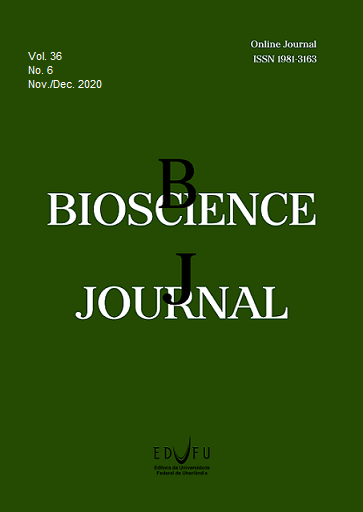Emergence and epidemics of a new disease in araguaia valley: anthracnosis of cotton caused by Colletotrichum truncatum, varietal reaction and difficulties of chemical control
DOI:
https://doi.org/10.14393/BJ-v36n6a2020-56826Keywords:
cotton, anthracnosis, fungicides, resistance, managemmentAbstract
Cotton culture (Gossypium hirsutum L.) is trending in an upward expansion amidst Brazilian “cerrado”. Due this growth, new pathosystems are growing in incidence on tropical fields in the region of Araguaia Valley - MT. Surveys and material collection were conducted out in production areas on two counties (Bom Jesus - MT and Canarana – MT), both regions represents a total amount of 50.000 hectares of cultivated area. The region also is characterized by succession areas previously sowed with soybean plants (main cover crop season). Previously surveys revealed the incidence of target spot (Corynespora cassiicola), ramularia spot (Ramularia areola) and cercosporiosis (Cercospora gossypii). Disease incidence is commonly observed on several crop management methods and cultivars. Due to a reduction in efficacy of chemichal control by fungicides spray programs, this disease is increasing and spreading in a faster rate in production areas with previous harvested soybean at the biggest soybean producer group in the world (Bom Futuro). Plants on field were selected due to differences in symptoms, and isolation methods were carried out on PDA (potato-dextrose-agar) before “in vitro” pathogenicity tests conducted on seedlings, detached leaves and bolls (growth chamber conditions of 23°C / photoperiod of 12 hours). After Colletotrichum dextructor sp. pathogenicity confirmation, bioassays were carried out with several different fungicide’s groups (i.e. registered for usage on Brazilian jurisdiction). This test consisted of the employment of a solution with 500 ppm of each different fungicide/a.i. that is applied on infected bolls and detached leaves who were inoculated with the target pathogen (concentration of 104 conidia per mL). This test was followed by an infection (%) evaluation during 10 days of incubation. The incidence/prevalence index (%) was also evaluated at different parts of the plant (lower, middle, and upper canopy) on different cultivars/genotypes (130-150 days after sowing). A standard level of control by different fungicides, ranged between 0 to 100% of control. Two groups of cultivars/genotypes were separated after differences on resistance response, one with susceptible traits (FM 985 GLTP) and other with partial resistance traits. No immunity response was observed. We suggest that new efficacy tests should be carried out with combination of varietal response (resistance or tolerance) combined with other chemical fungicides for better understanding of synergism or positive interaction. Valuable information will highlight the best association for greater varietal response and yield against this necrotrophic pathogen (higher B0 – initial inoculum) survival during successive years of rotation main crop (cotton x soybean). Isolated spray of benzimidazoles, cupric (except cuprous oxide) and triple associations with triazoles or triazolinthione (prothioconazol) combined with strobilurins and carboxamides should be wisely administrated to manage this disease due to low efficiency (below 50%). New field and laboratory essay must be carried out to input data about resistance risk and clarify damage levels on leaves and bolls impacting yield.
Downloads
Published
Issue
Section
License
Copyright (c) 2020 Fernando Cezar Juliatti, Fernanda Cristina Juliatti, Breno Cezar Marinho Juliatti, Cristiane Aparecida de Paula

This work is licensed under a Creative Commons Attribution 4.0 International License.





